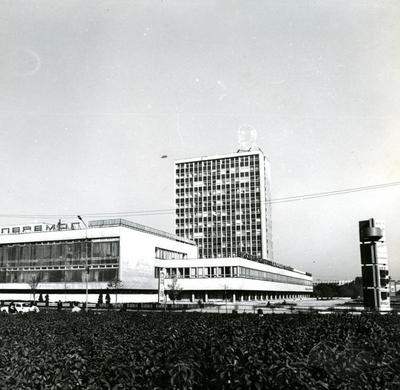Vul. Volodymyra Velykoho, 2 – the Vilna Ukraina (Free Ukraine) Print Works
The Vilna Ukraina Print Works and Publishing House was built in 1974, Volodymyr Doroshenko, architect. The style of construction – Industrial Soviet Modernism. As of 2012, the premises are occupied by the Vilna Ukraina Publishing offices, Ukrvydavpolihrafia, the editorial offices of the Vysoky Zamok newspaper, Ukrainskyi Shlyakh, Aviso, and Pricekurant magazine. Remaining warehouse and office space is occupied by a car dealership, a bank branch, a pool hall, as well as commercial printers.
Architecture
The print works is located in south Lviv, in the Syhnivka industrial zone at the T-intersection of Volodymyra Velykoho (formerly, Artema) and Stryyskoi Streets.
The intersection is a lively transportation hub, and the complex is set slightly back from Styyskoi Street, and is fronted by a large, concrete slab square dotted with lawn parking strips. Sometime later, the square was converted into a fenced parking lot. The plant structures are arranged around a commercial center. This 13-story office block houses the publishing house and stands on a two-story pedestal, with three stories for newspaper publishing, three stories for a print shop and paper warehousing, a power plant, compressor, and garage (SOE Design Institute, Chapter 3, 1989, 14).
The publishing house has a lobby, offices, a cafeteria seating 120, an assembly hall for 500, a demonstration hall, a communications wing, warehouses and service facilities (SOE Design Institute, Chapter 1, 1989, 55).
The spatial arrangement of the publishing house structure manifests two parallelepipeds (a geometric object with six faces, all parallelograms): a two-story horizontal pedestal and a thirteen-story vertical tower. Characteristic of spatial dimensions in classical modernism, these two objects are set at right angles to one another in a visually-consistent perpendicular on both the horizontal and on the vertical. The pedestal’s broad side faces Stryyskoi Street, and perpendicular to the tower’s lead edge, which faces Volodymyra Velykoho Street (SOE Design Institute, Chapter 3, 1989, 14).
The newspaper center houses its core shops – formatting, printing, and assembly – in the building facing Volodymyra Velykoho Street. Here, one finds the dispatch center, operations, and an area for paper preparation and facilities for employees.
The printing center houses engineering and other services, a shop producing consumer items, a section for typesetting of brochures, standard forms, and labels. The newspaper and printing houses are connected by an elevated walkway on the second floor.
The building office space is laid out along hallways. In the publishing tower, discrete offices line both sides of hallways which are joined by double staircases. The tower stands on an east-west axis with wide bands of windows on its northern and southern edges. Two elevators located at the end of the corridor provide the primary connection between floors. A monolithic concrete slab spiral staircase connects the lobby with the second story hall. The fluid form of the staircase adds contrast to an otherwise stark interior design.
The brick interior walls are plastered and painted in oil paint, and offices may be finished in wallpaper, ceramic tile, sheetrock, and natural stone. Offices enjoy parquet flooring, while the technical department and warehouse floors are covered in linoleum. The lobby/foyer and cafeteria have mosaic flooring (SOE Design Institute, Chapter 1, 1989, 55).
The structure itself is of precast reinforced concrete frame with conventionally spaced 6x6 cross-beam columns, interspersed with rigid diaphragmatic supports. The construction envelope consists of free-standing, attached light-concrete paneling (thickness, 240 mm), and bands of wood-frame aluminum windows (producer: Moscow Window Factory #4). The foundation is constructed of 30x30 cm reinforced concrete pilings, 10-12 meters in length. The assembly hall is covered with specially manufactured truss-work. All buildings are flat-roofed. (SOE Design Institute, Chapter 1, 1989, 55).
Despite the structure’s flaws – largely attributable to shoddy workmanship and materials – it has a pleasant line and a distinctive character, rendering the Vilna Ukraina Print Works and Publishing House a remarkable specimen of Soviet industrial modernist architecture in Lviv.
Personalities
Volodymyr Doroshenko. Architect, born March 25, 1922 in the town of Verbivka in the Kirovograd Region. Graduated Lviv Polytechnic Institute, 1948. Employed at the Lviv branches of Teploenerhoproekt, Dipromist, Prombudproekt, and other firms. Notable projects:
Kuznetsov Memorial, Lviv (1962, co-designer)
Reconstruction of the Porokhova Tower, Lviv (1957-1963, co-contributor, competition)
Vilna Ukraina Printing Works & Publishing House on Volodymyr Velykyi Street, Lviv (1973)
Private Apartment Residence, corner of Styyskoi and Sakharova Streets, Lviv
Lvivenerho Engineering-Laboratory Complex (1982)
Engineering Center for Druzhba arterial pipelines on Chornovola Street, Lviv (1984)
Sources
1. Vilna Ukraina Publishing. Company archives.
2. Lviv Prombudproekt Design Institute. Vilna Ukraina Publishing complex of Lviv Regional Committee of the Communist Party of Ukraine, Lviv. The annex to the newspaper division and the construction of the print works. Project Stage. Section 1. General Summary. (Lviv: PICTI, Lviv Construction Project, 1989. 55. Print.
3. Lviv Prombudproekt Design Institute. Vilna Ukraina Publishing complex of Lviv Regional Committee of the Communist Party of Ukraine, Lviv. The annex to the newspaper division and the construction of the print works. Project Stage. Section 3. General Plan. Lviv: PICTI, Lviv Construction Project, 1989. 14. Print.
4. Biriulyov, Yuryi. Architecture of Lviv: Times and Styles, 13th-21st centuries. Lviv: Center of Europe Publishing, 2008. 624-720. Print.
5. Hrinkevych, Miron. Creators of the Magical Column. Lviv: Vilna Ukraina Publishing, 2005. 149. Print.
6. Hofer, Adreas, Elizabeth Leitner, and Bohdan Tscherkes. Lemberg: Architecture and City. 100 Landmark Buildings. (Vienna: Lit Verlag GmbH & Co KG, 2012. 163. Print.
Media Archive Materials
Related Pictures




































